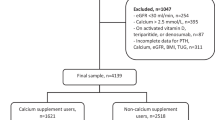Abstract
Purpose
The aim of this study is to analyse the percentage of hypovitaminosis D, as well as its relationship with the various parameters of calcium-phosphate metabolism.
Methods
A case control study was conducted on 366 patients, divided into two groups: Group 1: 127 non-stone-forming patients, and Group 2: 239 calcium stone forming. A study was performed on calcium-phosphate metabolism and urinary lithogenic factors. The percentage of vitamin D deficiency (25-OH-vitamin D levels <20 ng/ml) between the groups was analysed and compared. The SPSS 20.0 statistics program was used for the analysis, with a p ≤ .05 being considered significant.
Results
The mean age of Group 1 was 52.1 years compared to 49.6 years in Group 2, with no significant differences (p = .07). Vitamin D levels were lower in Group 2 compared to Group 1 (25.7 vs. 28.4 ng/ml, p = .02). A vitamin D deficiency was observed in 28 % of the Group 2 stone-forming patients versus 15.7 % in Group 1 (p = .009), with an odds ratio (OR) of 2.09 (95 % CI; 1.19–3.63). In the stone-forming patients with a vitamin D deficiency, the only difference observed was the higher levels of iPTH compared to those stone-formers with a normal vitamin D (56.9 vs. 45.5 pg/ml, respectively; p = .0001).
Conclusion
Calcium stone-forming patients have lower mean levels of vitamin D and a higher percentage of hypovitaminosis D than in non-stone-forming patients. This was only related to increased iPTH levels, with urine calcium and other lithogenic parameters having no obvious effect.
Similar content being viewed by others
References
Tang J, Chonchol MB (2013) Vitamin D and kidney stone disease. Curr Opin Nephrol Hypertens 22:383–389
Guessous I (2015) Role of Vitamin D deficiency in extraskeletal complications: predictor of health outcome or marker of health status? Biomed Res Int 2015:563403. doi:10.1155/2015/563403
Pipili C, Sekecioglu N, Oreopoulos DG (2012) Normocalcemic hyperparathyroidism in patients with recurrent kidney stones: a disease entity or vitamin D deficiency? Clin Nephrol 77:352–357
Hansen KE, Jones AN, Lindstrom MJ, Davis LA, Engelke JA, Shafer MM (2008) Vitamin D insufficiency: disease or no disease? J Bone Miner Res 23:1052–1060
Nguyen S, Baggerly L, French C, Heaney RP, Gorham ED, Garland CF (2014) 25-Hydroxyvitamin D in the range of 20 to 100 ng/mL and incidence of kidney stones. Am J Public Health 104:1783–1787
Ticinesi A, Nouvenne A, Ferraro PM, Folesani G, Lauretani F, Allegri F, Guerra A, Cerundolo N, Aloe R, Lippi G, Maggio M, Gambaro G, Borghi L, Meschi T (2015) Idiopathic calcium nephrolithiasis and hypovitaminosis D: a case-control study. Urology. doi:10.1016/j.urology.2015.10.009
Penniston KL, Jones AN, Nakada SY, Hansen KE (2009) Vitamin D repletion does not alter urinary calcium excretion in healthy postmenopausal women. BJU Int 104:1512–1516
Haghighi A, Samimagham H, Gohardehi G (2013) Calcium and vitamin D supplementation and risk of kidney stone formation in postmenopausal women. Iran J Kidney Dis 7:210–213
Blann A (2015) An update on vitamin D deficiency and at risk groups. J Fam Health 25:16–19
Kalra S, Aggarwal S (2015) Vitamin D deficiency: diagnosis and patient centred management. J Pak Med Assoc 65:569–573
Wierzbicka J, Piotrowska A, Żmijewski MA (2014) The renaissance of vitamin D. Acta Biochim Pol 61:679–686
Fallahzadeh MH, Zare J, Al-Hashemi GH, Derakhshan A, Basiratnia M, Arasteh MM, Fallahzadeh MA, Fallahzadeh MK (2012) Elevated serum levels of Vitamin D in infants with urolithiasis. Iran J Kidney Dis 6:186–191
Shakhssalim N, Gilani KR, Parvin M, Torbati PM, Kashi AH, Azadvari M, Golestan B, Basiri A (2011) An assessment of parathyroid hormone, calcitonin, 1,25 (OH)2 vitamin D3, estradiol and testosterone in men with active calcium stone disease and evaluation of its biochemical risk factors. Urol Res 39:1–7
Adams JS (1996) Regulation and actions of vitamin D. In: Coe F, Favus M, Pak C, Parks J, Preminger G (eds) Kidney stones. Medical and surgical management. Lippincott-Raven, Philadelphia
Sakhaee K, Maalouf N, Kumar R et al (2011) Nephrolithiasis-associated bone disease: pathogenesis and treatment options. Kidney Int 79:393–403
Tang J, McFann K, Chonchol M (2012) Association between serum 25-hydroxyvitamin D and nephrolithiasis: the National Health and Nutrition Examination Survey III, 1988–94. Nephrol Dial Transpl 27:4385–4389
Pipili C, Oreopoulos DG (2012) Vitamin D status in patients with recurrent kidney stones. Nephron Clin Pract 122:134–138
Eisner BH, Thavaseelan S, Sheth S, Haleblian G, Pareek G (2012) Relationship between serum vitamin D and 24-hour urine calcium in patients with nephrolithiasis. Urology 80:1007–1010
Elkoushy MA, Sabbagh R, Unikowsky B, Andonian S (2012) Prevalence and metabolic abnormalities of vitamin D-inadequate patients presenting with urolithiasis to a tertiary stone clinic. Urology 79:781–785
Ketha H, Singh RJ, Grebe SK, Bergstralh EJ, Rule AD, Lieske JC, Kumar R (2015) Altered calcium and vitamin D homeostasis in first-time calcium kidney stone-formers. PLoS One 10:e0137350
Leaf DE, Korets R, Taylor EN, Tang J, Asplin JR, Goldfarb DS, Gupta M, Curhan GC (2012) Effect of vitamin D repletion on urinary calcium excretion among kidney stone formers. Clin J Am Soc Nephrol 7:829–834
Elkoushy MA, Jundi M, Lee TT, Andonian S (2014) Bone mineral density status in urolithiasis patients with vitamin D inadequacy followed at a tertiary stone centre. Can Urol Assoc J 8:323–328
Acknowledgments
To Programa de Doctorado de Medicina Clínica y Salud Pública. Trabajo de tesis doctoral de María Sierra Girón Prieto dirigido por Miguel Ángel Arraba-Polo y Salvador Arias Santiago.
Author information
Authors and Affiliations
Corresponding author
Ethics declarations
Conflict of interest
The authors declare no conflict of interest
Ethical statement
It is a low ethically responsible study in which the patients gave their informed consent after reading the Patient Information Sheet. The study was approved by the Hospital Ethics Committee.
Rights and permissions
About this article
Cite this article
Girón-Prieto, M.S., del Carmen Cano-García, M., Arrabal-Polo, M.Á. et al. Analysis of vitamin D deficiency in calcium stone-forming patients. Int Urol Nephrol 48, 1243–1246 (2016). https://doi.org/10.1007/s11255-016-1290-3
Received:
Accepted:
Published:
Issue Date:
DOI: https://doi.org/10.1007/s11255-016-1290-3




